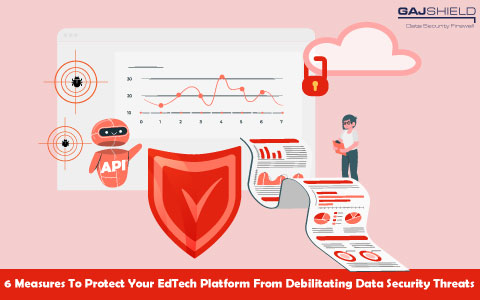6 Measures To Protect Your EdTech Platform From Debilitating Data Security Threats
The relentless advancement in technology brings with it the ever-increasing risk of cyber attacks. One industry that is steadily adopting new technologies and has thus become vulnerable to cyber attacks is EdTech. With more schools integrating technology into their systems, the threat to data security keeps rising. In the first quarter alone of 2022, India was exposed to 18 million attacks and threats. When someone uses Edtech applications using their school’s credentials, they are increasing the vulnerability of their data to cyber criminals.

Ransomware attacks are one of the most commonly faced data security breaches in schools. It is reported that lower education institutions have seen a rise in ransomware attacks by 56%, while higher education ones have reported an increase of 64% in 2021. Besides ransomware, Edtech companies also face the risk of account takeovers, which can be used to hack into the payment information of students and parents. The ransomware can also send phishing emails and increase the attack surface. Cyber criminals can also erase the entire data from a school’s system or can use the data for identity theft. This makes data security and cybersecurity of utmost importance to the EdTech platforms.
Measures to Protect EdTech Platforms
Managing and catching risks to EdTech platforms against cyber attacks and threats is a top priority for companies and schools worldwide.
1. Hunting For Threats
To track down a threat, security teams should proactively lookout for malware or other vulnerabilities surrounding their system. With recent technological advancements, cyber attackers are getting better at concealing themselves within your systems. Due to this advancement, it takes too long for the security teams to figure out any abnormalities with their systems. Their data security is then easily breached, leading to all sensitive information being leaked. One way to track down such threats is to sift through all login information and perform an in-depth analysis. The ones that are not aligned with the regular network should be investigated and checked for suspicious activities.
2. Integrating Automatic Action
Identifying Edtech and SaaS applications such as Office 365 for any potential risks is necessary. The potential of the threat should be classified automatically. After identifying the threat, actions must be taken to block, sanction, or remove it at the source.
3. Monitoring Security Tools
Apart from integrating your EdTech systems with enhanced security tools, monitoring the activities within the system is also essential. This will provide the security team with insights into any actions occurring from the tools in the overall network security. One efficient and effective way to monitor all security devices and tools from a single place is to deploy enhanced security information and event management (SIEM). This comprehensive platform can provide insights from all your tools, such as firewalls, antivirus software, and other security devices, by gathering information through the log data. From this information, SIEM will initiate remediation responses and produce a report. This report can help you understand indicators of attack and take proactive steps to prevent it.
4. Restricting Unauthorised Access to Network
In addition to reviewing your server logs for hunting malware and incorporating an enhanced firewall, ensuring that no unauthorized users can access the network is vital. Security measures such as the use of VPN for encrypted communication and multi-factor authentication are essential. To protect from any malicious attachments sent via emails, emails should be filtered to ensure data security. It should be inculcated to the teachers, administrators, and students to use strong passwords. Least privilege access or zero trust network is also an important security measure to enforce.
5. Constructing Incident Report Plans
Waiting for a heavy attack to plan for cybersecurity will create a big hole in your finances. It takes one cyber attack to completely destroy the security network, no matter how strong the organization might think its data security is. To prepare for the worst, a well-crafted incident report plan is quintessential. An incident report plan is a blueprint or framework to help EdTech companies detect, counter, and recuperate from any incidents affecting the network’s security.
6. Deploying Cloud Security
Even though many companies don’t like to accept it readily, data leaks or data threats because of internal data thefts perpetrated by employees represents a staggering percentage of breaches. It is reported that 57% of fraudulent cases are employee generated. Integrating cloud security into your system makes it easier to protect your data against fraud as well as meet the governmental requirements on compliance. Cloud security ensures data security because it encrypts data transferred over networks or stored in the database. Users can set different security settings as an added measure for data security.
Evading cyber attacks on EdTech platforms by managing risks to the organization’s cybersecurity is essential. EdTech companies must ensure that they have the leading automated cybersecurity solutions integrated into their systems to protect against any leaks of sensitive information that could harm them and their clients.
With more students enrolling in e-learning programs, the EdTech vendors must be equipped with the necessary cyber security solutions. GajShield provides its clients with SaaS data control, cloud-based data security solutions, data visibility and control, and more to keep their data secure and protected from any cyber threats that might loom over their clients.
Contact us to know more about our cyber security solutions.
Get In Touch With Us
Subscribe to our Newsletter
2025 © GajShield Infotech (I) Pvt. Ltd. All rights reserved.
